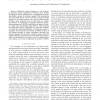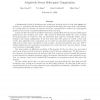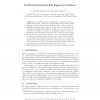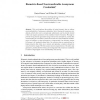370 search results - page 44 / 74 » Limits of Constructive Security Proofs |
CDC
2008
IEEE
14 years 2 months ago
2008
IEEE
— Initial-state opacity emerges as a key property in numerous security applications of discrete event systems including key-stream generators for cryptographic protocols. Speci�...
STOC
1996
ACM
14 years 7 days ago
1996
ACM
A fundamental problem in designing secure multi-party protocols is how to deal with adaptive adversaries i.e., adversaries that may choose the corrupted parties during the course ...
CTRSA
2010
Springer
14 years 2 months ago
2010
Springer
Sanitizable signature schemes allow a semi-trusted entity to modify some specific portions of a signed message while keeping a valid signature of the original off-line signer. In...
ICICS
2009
Springer
14 years 2 months ago
2009
Springer
This work explores the problem of using biometric data to achieve non-transferability of anonymous credentials; that is, sharing of anonymous credentials, which allow one to anonym...
FSTTCS
2010
Springer
13 years 6 months ago
2010
Springer
Oblivious transfer is a fundamental primitive in cryptography. While perfect information theoretic security is impossible, quantum oblivious transfer protocols can limit the disho...




